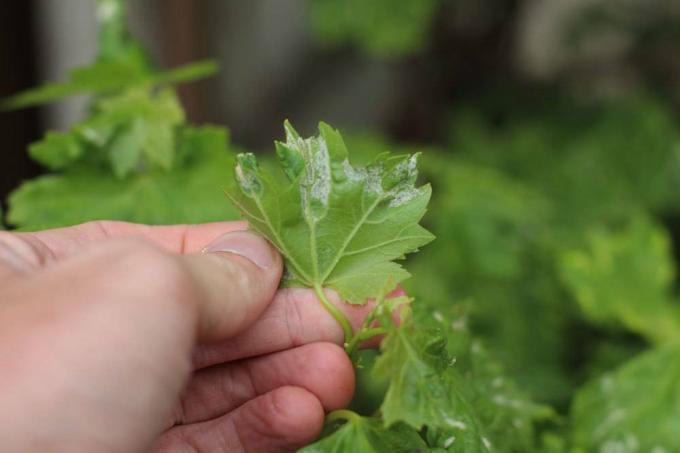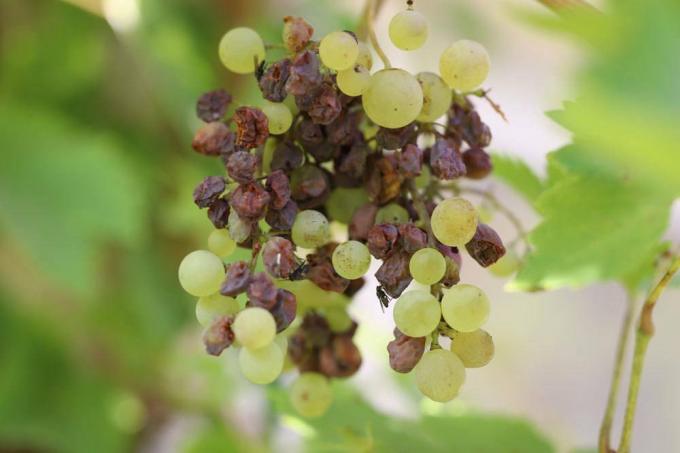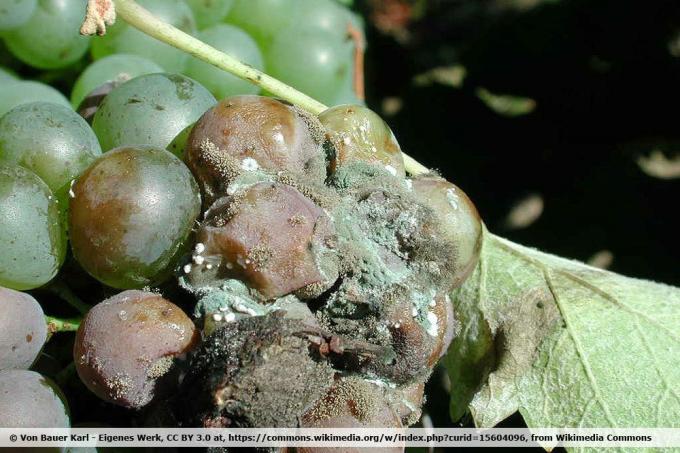
table of contents
- Common grapevine diseases
- Powdery mildew and downy mildew
- Red burner
- Black spot disease
- Green rot
- Gray mold
- Vinegar rot
- Black rot
- Esca disease
Grapevines (Vitis) are not only very decorative, they provide shade, beautify house walls and, with a little luck, produce delicious grapes year after year. Whether yellow, green, blue or pink, grapes grown on site simply taste best. However, grapevines can cause numerous, more or less persistent diseases. Then it is important to react quickly and take appropriate countermeasures to prevent individual plants from spreading or dying off.
Common grapevine diseases
Some wine diseases can cause great damage and severely affect the vines. Others do not pose a great danger. They can usually be recognized by the leaves and fruits of the grapevines and often clearly assigned to the different wine diseases. This makes it possible to fight them quickly and in a targeted manner. However, effective control is often only possible with good prevention. But what are the most common diseases of the grapevine and how can they be most effectively combated?
Powdery mildew and downy mildew
Powdery mildew
- One of the most dangerous diseases of the grapevine
- Growth on walls and walls can encourage infestation
- The disease affects all green parts of the plant as early as spring
- Fungus develops particularly well in dry weather
- Usually recognized relatively late
- Only when the grapes do not develop properly, turn dark and burst
- Further symptoms are dark gray discoloration of the leaves and annual shoots
- Fungus overwinters in buds and breaks out again the next year

Wrong mildew
- No less dangerous
- In contrast to powdery mildew, prefers persistent moisture
- Mainly occurs where it is not protected from rain
- Develops on the undersides of the leaves
- Shows up in the form of a white mushroom lawn
- The grapes can also be affected

Both types of powdery mildew can be controlled in a similar way. You should start with the budding by spraying the grapevine with network sulfur. If used preventively several times a year and over several years, it can prevent infection. The sulfur destroys almost all insects in the vine, unfortunately also the useful ones. With an initial infestation, all infected parts of the plant should be removed and the vines thinned out.
Red burner
The so-called red burner is a fungal disease that affects both leaves and inflorescences. It occurs particularly on stony, low-humus, shallow and dry slopes.
- First symptoms visible after about 2-3 weeks
- Around the end of May to the beginning of June, infestation of the leaves in the form of spots
- In light varieties, spots are yellowish to brownish, with a light green border
- For red wines, ruby red with a yellow edge
- In the further course, the affected areas turn brown and dry up
- A renewed infestation is possible in some cases in July / August
- After frequent rainfall, the risk of renewed infestation is particularly high
- Infestation of the inflorescences is also possible
- Affected inflorescences dry up
Most grape varieties are susceptible to this disease. Accordingly, grapevines should be treated preventively, at the latest at the beginning of the infestation, with approved plant protection products. The first treatment should be from a shoot length of approx. 10 cm or from 4-5 fully developed leaves. It is best to spray shortly before precipitation or immediately after it. As a rule, a second and third treatment are required, every 8-10 days.

tip: The fungus overwinters in the vine leaves lying on the ground. If this is not completely removed, the risk of infection in the next year is very high.
Black spot disease
Black spot disease, also known as shoot necrosis, is also caused by a fungus. It attacks all living, green parts of the plant and is particularly evident on the shoots and leaves. Infestation usually occurs from June and is favored by a low pH value of the soil, too much moisture and too high a nitrogen supply. It is most common in regions with high levels of precipitation.
- The first signs to be seen on the leaves that are still growing
- They have a slight bronze-like discoloration
- They mostly go unnoticed
- Visible symptoms appear later
- In the form of point-like lightening and deformations on the leaves
- Scab-like necroses form underneath infected, lignified parts of the vine
- Dying plant tissue is called necrosis
- Can also appear on all green parts of the plant
- Infected grapes turn dark blue to black
- If the infestation is severe, the shoots close to the trunk cripple
- In winter, fungus grows in parts of the bark that have not been damaged until then
- From February in the white parts of the bark, small black dots can be seen
- Points are the spore beds of the fungus
Since this fungus overwinters in annual and perennial wood as well as on the bark, it is important to cut out all infected parts. As a rule, stick tapering below the affected wood on the wine is advisable. The trunk is then rebuilt in this area.
The infested wood removed from the wine should be disposed of with household waste, but ideally it should be burned. In addition, fungicides can be used for treatment, which should be applied before precipitation or in wet and cold weather. The first treatment is started when the buds burst or the first green shoot tips becoming visible. Another treatment should be carried out after about ten days.
tip: Approved pesticides based on sulfur are very suitable for the first spraying.
Green rot
Green rot is a putrefactive pathogen that mainly occurs on grapevines in warm, humid weather and predominantly in years when the berries ripen very early. Grapes that have been injured or damaged for various reasons are attacked. Be it by wasps or birds, hailstones, pressed, burst berries, worm infestation or sunburn.
- Affected ripe berries on the wine turn light brown in color
- A little later, initially white, then blue-green pustular spore beds can be seen
- Green rot often occurs together with botrytis (gray mold) and vinegar rot
- Infested grapes must be removed
- Otherwise they could endanger the grapes
- There are no fungicides that are sufficiently effective against green rot
As a result, the prevention Also of particular importance in combating this disease. It is designed in such a way that injuries to the grapes should be avoided as far as possible, and regular pruning measures on the wine should ensure that the vines are well ventilated. On the other hand, a partial defoliation of the grape zone can be useful. In addition, the risk of infection can be reduced by combating botrytis.
Gray mold
Gray mold is one of the wine diseases caused by fungi, especially those of the Botrytis genus, and occurs mainly in damp and cool late summers. Types of wine that form very dense grapes are particularly susceptible. However, it is relatively rare to find it in sheltered places.
If there is an infestation, it shows up in black-brown discolored areas on young shoots, leaves, stems and grapes. Leaves and grapes wither and rot. Infested buds also turn brown. Infested parts of the plant should be cut out consistently to prevent them from spreading. In addition, leaves and shoots are repeatedly dusted with primary rock flour.

tip: As a preventive measure, to protect against diseases, make sure there is sufficient spacing between the plants and the wine should be blended regularly. Plant strengthening agents make the wine more resilient.
Vinegar rot
Acetic acid bacteria and yeasts, which ensure that the pulp and juice of the grapes ferment, are responsible for the formation of vinegar rot. It is the result of previous injuries to the grapes, whereby an infection only occurs if there is sufficient sugar and moisture on the grape skin.
- Infested grapes give off an intense vinegar smell
- In the final stage, they turn reddish-brown
- A short time later they are hollow
- Vinegar flies are often found in and on the berries
- They can contribute to the spread of this disease
- A direct fight against vinegar rot is not possible
- Again, the best control is good prevention
- Preventive measures are the same as those for green rot

tip: Both whole grapes and grape parts on the wine that are affected by green or vinegar rot, shouldn't be removed too early as that would reduce the pressure of infection on the remaining berries raise.
Black rot
Black rot is also one of the wine diseases. Similar to green and vinegar rot, it also occurs predominantly in areas with increased rainfall in spring and early summer. Leaves and shoots of infected vines have small, sharply defined, light spots with a dark brown border. Small, shiny, black dots, the fruiting bodies of the fungus, can be seen on dead tissue. The grapes initially have pale spots, which later turn reddish brown and finally black and die off. Even unripe berries have light, reddish-brown spots, they dry up within a few days. What remains are fruit mummies on which the fruiting bodies sit, in which the fungus hibernates.
There are no effective approved pesticides against black rot. The effects of copper and sulfur are also limited. A particularly high risk of infection comes from neglected, no longer cultivated vineyards in the vicinity. In order to combat black rot effectively, clearing such areas is recommended. In addition, fruit mummies should be sorted out and disposed of during harvest, and regular pruning measures should ensure that the vines are well ventilated.
Esca disease
Several fungi are involved in the Esca disease outbreak. Symptoms of this disease can appear during the entire vegetation period, but mainly from midsummer and in older vineyards. The clinical picture can be acute or chronic.
- In acute form, leaves and grapes suddenly die off and dry up
- In the chronic, light spots of different sizes between the main veins of the leaves
- Spotty areas die off later
- What usually remains is a narrow green stripe along the larger leaf vein
- Green stripes outlined in yellow for white wine varieties, and wine-red for red varieties
- Leaves dry up and fall off prematurely
- Brownish-purple to gray spots can be seen on the grapes
- Berries that are still young shrivel
There are no special means of combating this either. Trunk restoration can be useful, especially with young vines. To do this, they are cut back into healthy wood in winter. Any clippings should be disposed of with household waste or burned. As with most wine diseases, prevention is the best protection for Esca disease.






